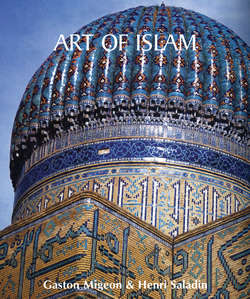Читать книгу Art of Islam - Gaston Migeon - Страница 28
На сайте Литреса книга снята с продажи.
Architecture
C–Iran and the Persian School
The Friday Mosque of Isfahan
ОглавлениеThe plan of this mosque is unique. It has a vast square courtyard, with a square pavilion in the middle. The four sides of the courtyard are decorated with huge, arched gates, linked to each other via porticos with two-tiered arcades. The tallest and most attractive of them, leading to the sanctuary itself, is flanked by two big minarets. The minarets, which may actually be likened to huge chimney stacks, are slightly conical, ending in a balcony supported by stalactite-like corbels, from where the muezzin calls the faithful to prayer.
The plan of this mosque is very different from the classical plan of early mosques in the area. Its square courtyard and the huge gates, which are fairly reminiscent of the gigantic arch in Khosrau’s palace in Ctesiphon, are the distinguishing elements of the mosque. The rest are beam fillings, such that, in the end, there seem to be four mosques with parallel and multiple naves. It was simply hollowed out in the middle, and still stands because all the area from the base of each side of the sanctuary seems identical and apparently forms a separate mosque on either side, each with its own mihrab. In between these two wings, the real sanctuary is sheltered by a huge dome.
The vaults are either supported by square pillars or by four attached columns. The dome is supported by the columns and surmounted by an internal dome made of bricks laid out according to the sinuous ribs, which are separated by blue faience mosaic panels on a yellow background and overlaid with an external dome decorated with faience.
The arch of the main porch is extraordinary, not only because of the faience and enamelled brick decoration and the two minarets lined with enamelled bricks, but also and most importantly because of the way it was constructed. The rectangular plan on which it is constructed does not actually constitute a cradle; it is a half-dome preceding a dome, both of them star-shaped, which have been able to restore this rectangular plan through a succession of stalactites in the form of tiered corbels on a triangular plan. This succession of tiered stalactites is distinctive, and the vaults seem to float in the air.
The stalactites are made of pink enamelled bricks. The interior and exterior of the entire building are lined with enamelled tiles, painted in bright and stunning arabesques, while the base is decorated with beautiful wavy and banded porphyry tables, which Abbas the Great wanted to be used in the royal mosque. The ornamentation is exquisite everywhere – the entire lengths of walls, on friezes and cornices – and contains verses of the Holy Koran and utterances of imams. The main dome has a diametre of more than 30 metres. In front of this dome, which is like the choir space of the mosque, there is a spacious courtyard surrounded by cloisters with arcade fronts and supported by huge pilasters of the same craftsmanship as the domes. This mosque has two minarets embellished with enamelled bricks and seven doors. Each of the main entrances to this huge edifice has a specific name, and, like the domes and towers, some of them name the particular founder, since numerous princes contributed to the construction of this mosque. On the frontispiece is inscribed in bold letters the name of each prince, as well as those of the architects and main workers.
Конец ознакомительного фрагмента. Купить книгу
